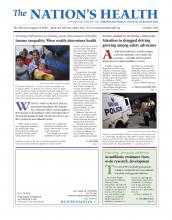Children are among the poorest populations in the U.S., with more than 21 percent living in poverty as of 2014. And research finds that such economic circumstances are among the greatest threats to a child’s health and well-being both before and after birth.
According to the National Center for Children in Poverty, 44 percent of all U.S children younger than 18 — or more than 31 million youth — either lived below the poverty level or just above it in 2014.
Among the nation’s 11 million very young children — infants and toddlers younger than 3, who are going through highly sensitive developmental phases — about a quarter were living below 100 percent of the federal poverty level in 2014. Unfortunately, such poverty statistics represent an increase over previous years.

A child whose family is homeless plays while staying at a shelter in August 2015 in Atlantic City, New Jersey. Health risks associated with childhood poverty include inadequate nutrition and a higher incidence of chronic disease.
Photo by John Moore, courtesy Getty Images
The health risks associated with childhood poverty range from higher infant mortality risks to inadequate nutrition to a higher incidence of chronic disease, all of which contribute to a child’s school readiness, opportunity to learn and future health trajectory. For example, children living in low-income families are more than twice as likely to have asthma, a major contributor to school absenteeism, than children in higher-income families.
“Poverty is toxic,” Deborah Frank, MD, founder and a principal investigator of Children’s HealthWatch at Boston Medical Center, told The Nation’s Health, adding that 30 to 40 percent of children younger than 4 coming through the medical center’s pediatric emergency room are living in food-insecure households. “In this country, childhood poverty is about policy change. It’s not an unavoidable act of God.”
One such policy change is raising the minimum wage. In an August study in APHA’s American Journal of Public Health, researchers examined the effect of minimum wage on infant mortality and low birthweight, a predictor of infant death. The study found that a $1 increase in the minimum wage above the federal level was associated with a 4 percent decrease in infant death during the first year of life. In fact, the study found that if all states had boosted their minimum wages by $1 in 2014, more than 500 infant deaths and nearly 3,000 low-weight births could have been prevented.
Another study, released in July from the National Bureau of Economic Research that examined birth data over 25 years, found that increases in the minimum wage were associated with higher birthweights as well as an increase in prenatal care utilization and a decline in smoking during pregnancy.
Frank, who also serves as director of the Boston Medical Center Grow Clinic, which provides specialty care to children suffering from malnutrition, said raising the minimum wage is one way to impact child health, though it is not a panacea. Instead, she said a combination of policy solutions, including ensuring a basic income floor for all, is needed to ensure all children have a chance to thrive.
“We have all the technology, all the food, all the trucks we need to make sure everybody is adequately nourished,” she said. “What’s missing is political will.”
For more on child health and poverty, visit www.childrenshealthwatch.org.
- Copyright The Nation’s Health, American Public Health Association









